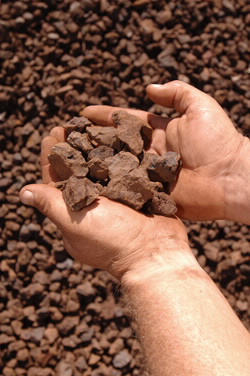 |
| Rare earth elements with unique properties are often referred to as the vitamins of the electronics industry. |
What comes out of dirt and is found in mobile phones, Mp3 players, cameras, cordless power tools, wind turbines, hybrid vehicle batteries and even the powders that polish our television screens?
The answer is 'rare earths' an odd assortment of elements with unique properties sometimes referred to as the vitamins of the electronics industry.
While many of us may never have heard of elements such as lanthanum, neodymium, terbium or europium, they are crucial components in a range of gadgets that are increasingly important in modern life. Because of their high-tech applications, including many new green technology applications, the demand for rare earth elements has increased dramatically in recent years.
China currently supplies the vast majority of the world supply of rare earths, but a number of Australian mining firms are looking to establish themselves in the market; particularly as worldwide shortages of some elements become a concern.
This boom in demand is being mirrored by the demand for experts from ANSTO Minerals to help companies extract and recover these valuable commodities. A team of 60 professional scientists and technicians with expertise in chemical engineering, metallurgy, mineralogy, chemistry, geology and radiation safety are sought out to solve problems.
One such expert, Doug Collier, said that the business unit is well situated to benefit from the general increased interest in rare earths.
"Extracting the rare earth elements from the earth can be more complicated than extracting more common elements because there are many different elements, and there may be few mines on which to model operations," said Doug.
Indeed, there are nearly as many ways to extract rare earths as there are different minerals. It is a very complex process requiring many laboratory tests before pilot plants can even be designed
Typically, the soil goes through a variety of washing and filtering stages using different chemicals. Each process may need to be tailored to the element being sought, and to the different kinds of ore. As the industry expands, new methods for extracting the precious oxides are rapidly being developed.
"Because we have such a broad range of expertise to draw on, we are in great demand for pilot plant design and operation by mining companies. We can tackle most of the processing issues that may arise," said Doug.
ANSTO Minerals works extensively with Australian firms, but is increasingly dealing with international clients who are eager to tap into the organisation's world-class test and analytical facilities.
ANSTO possesses a range of modern analytical tools such as gamma spectrometry, radiochemistry, and delayed neutron counting that can make all the difference for miners seeking to understand how to treat their ores and create viable mines.
As the mining boom continues, Australia is well positioned to capitalise on future opportunities.
Published: 08/04/2010

